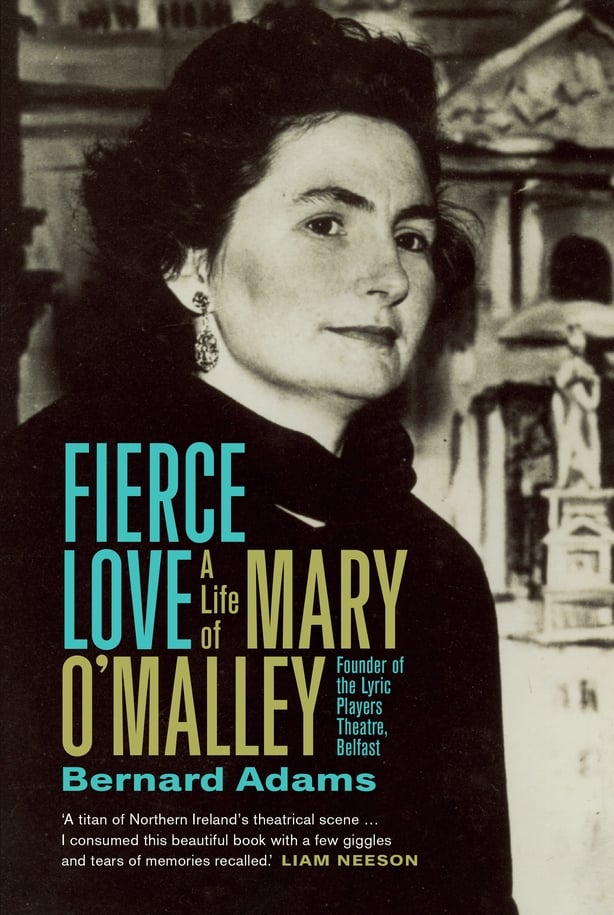We present an extract from Fierce Love: The Life of Mary O'Malley, the new biography of Cork-born theatre pioneer Mary O'Malley (1918-2006), who was the founder and director of Belfast's Lyric Players Theatre from 1951-81.
Sourced from production notebooks and copious correspondence held in NUI Galway, Fierce Love measures for the first time the achievements of a controversial and resourceful woman swimming against the tide of populism and sectarianism to establish an independent academy for actors and artists in a tireless quest for imaginative freedom and excellence...
Nightfall to Belfast closed on Saturday night. The dress rehearsal of The Ruling Class was scheduled for Monday, with the play opening the next day. The late evening of that Monday, 4 September 1973, was mild and still in Ridgeway Street. A vehicle drove up the sloping street and stopped close to the Lyric Players Theatre. It was followed by a police car. Men got out of both vehicles. Inside the playhouse Mary was sitting with her husband Pearse in the stalls, closely watching the proceedings on stage. Suddenly there was an outburst of shouting backstage. Mary says: 'The security man dashed in and told us to evacuate immediately, there was a bomb. The cast and stage staff were already on their way out backstage when we joined the queue – so quickly that I left my glasses and handbag on the floor.' (Mary shared with her bête noire, the Queen of England, a strong attachment to her handbag. Black, shiny and sizeable, it is her default accessory in many group pictures.) She and Pearse rushed out through the stage door into a lane behind the houses. There they found actors in full costume mingling with British soldiers who were asking people to leave their homes. The residents were not pleased: it was 11 pm and they were ready for bed, if not there already.
As the little band of players stood, waiting, under the streetlights, with the shape of the theatre outlined against the night sky, Pearse began to worry about the family car. Because bomb attacks had become frequent, he had parked it defensively to block off the Lyric’s side entrance. Now the suspicious car, which had been followed by the police, was parked beside it. There was intense activity. Men had been arrested and the area was being cleared. There was nothing Pearse could do, so they waited …
Mary’s description of what happened next is strangely ambiguous. ‘A controlled explosion, after what seemed like hours, finally took place. Smoke and flames enveloped the theatre and there was palpable anguish all round. My feelings were mixed. Escape at last, an end to fatigue and worry; sadness of course.’ This strange fatalism is followed by quiet pleasure that Pearse’s choice of parking spot had helped to save the fabric of the building. ‘The vehicle with the bomb had backed against our car which was destroyed by the impact of the explosion with the chassis ending up on the green in front of the theatre. Our car had served its purpose and prevented more serious damage.’
As they moved back towards the theatre it was clear that, astonishingly, not one pane of glass had been broken and ‘in true thespian spirit we marched back into the theatre and finished the rehearsal in the early hours’. The show opened the next night and its crazy, violent satire was popular with Belfast audiences. Only the set suffered from ‘the bombers’ visit. The delay it had caused prevented all the buttons on the padded cushions being in place before the first-night curtain went up.
The next day the press reports were low-key. ‘Only blast damage to the Lyric and houses in Ridgeway Street when the car bomb went off a few minutes before midnight.’ In the Belfast Telegraph this incident in the city is just one in a round-up of other potential tragedies all over the province. In the Falls Road in Belfast ‘a masked man burst into a house … occupied by three pensioners and opened fire at soldiers across the street’. In Derry a man opened up with a Thompson machine gun on an army patrol, putting at risk the lives of children playing in the area. In Lisburn youths who had been stoning taxis were arrested. Such was life in Northern Ireland when the Lyric was almost obliterated.
The bomb turned out to have been a 200-pounder; the bombers motivation was unclear, although they were almost certainly Loyalists. Why a window-cleaner, an unemployed salesman and a joiner wished to destroy almost the only centre of live entertainment remaining in Belfast was not explained when they eventually appeared in court. The playwright, Peter Barnes, horrified by the turn of events, sent from England a warm thankyou letter to the cast, director and crew. One of the actors involved, Linda Wray, adds two first-hand details to the story. ‘There was a sort of alleyway up to the stage door and the car was parked there – we didn’t know it was the car with the explosives in it and we all just ran past it and up into Ridgeway Street.’ After the controlled explosion she remembers going back into the theatre and finishing the dress rehearsal despite the ‘unbelievable smell of cordite’. But the show had to go on – and did.

Fierce Love: The Life of Mary O'Malley is published by Lilliput Press

